I had decided to take up the teaching job near Saigon but an expiring visa meant that I needed to exit Vietnam and come back with a new visa. Cambodia was the closest exit and I had a Cambodian visa ready. There are regular buses from Saigon to Phnom Penh and I took one of the many. This was to be my first over-land border crossing and I had little idea what to expect.
A Night in Saigon
I stayed up till 4 in the morning to watch Italy lose in the most pathetic penalty shoot out ever! I think people deserve better than that for their time. Anyway, I quickly packed up and checked out of my guest house in Mui Ne. A bit of walking up and down the road helped me find the cheapest price for a bus to Ho Chi Minh City, still aliased as Saigon or HCMC. Weirdly the rates are not standard and every tour agent quotes a price of his own. I bought a ticket for 120 kVND, dropped my bags and then went to have some breakfast and kill time till the bus was due.
Pro Tip #12
Unless you know of a good service and are booking from it’s office, it is usually a good idea to ask around to get an idea of the usual rate for tickets. You might be able to save more money than you might have thought.
The bus was a “sleeper”, in keeping with the standards of Vietnam. I made myself comfortable in my seat and dozed off as usual. By the time I woke up, the bus was rolling into Ho Chi Minh City. The bus made it’s way to District 1 and stopped at the bus stand there.
I got off and the first thing I did was to go back to a Burger King I had seen a little distance from the bus stand! I ordered a Double Whopper, my BK favourite, which cost me more than two meals (not by District 1 standards though) but filled me up for the rest of the day. I am not sure whether I liked it though. I was looking for some comfort food and the burger suddenly felt alien and dry midway through. I was surprised at myself for thinking that I would have gladly traded it for a Bun Thit Nuong!
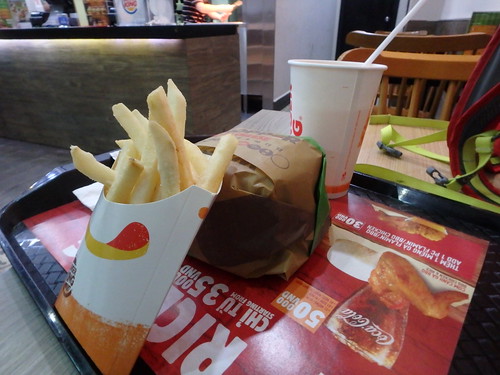 Double Whopper no longer cuts it!
Double Whopper no longer cuts it!
This entire area was a travel hub and I walked past many shops advertising buses to Phnom Penh. I was not sure whether I would go the next day or the day after so I just fished around for a good price. The prices varied from 10 - 13 USD. I walked up to my hostel, on the “outskirts” of District 1, and checked in. The room was something of a suite converted into a dormitory by stuffing bunk beds inside it. It was pretty comfortable though and had a few long term dwellers in it who were interesting in their own sense.
There was Miguel, a Spaniard, who was working as an English teacher in Saigon and liked smoking weed. He had faked his certification to get the job and offered to make a fake certificate for me as well. He had been doing it since high school, as he told me. 👏 Then there was Tomas, a freelance consultant for Microsoft Office 360 who incessantly talked about his job and the greatness of the product he was selling. He was Vietnamese and had a thing or two to say about the Vietnamese government and the Americans. These are the topics that I was looking forward to learning about during my month long teaching stint. There was another gentleman who sold some kind of nutrition drink and kept to himself mostly.
I sat a while and then went back to the bus station area to figure out a transportation to Phnom Penh. I walked around and eventually took a 10 dollar bus that had a decent online review - Phuong Heng. Then I wandered about and came upon the famous backpacker street of Saigon, Pham Ngu Lao street. It was right behind the bus station lane. I walked down on a road full of bars and pubs playing loud music, good looking girls dressed in luring clothes inviting you for a drink or a massage, vendors selling everything from sunglasses to drugs.
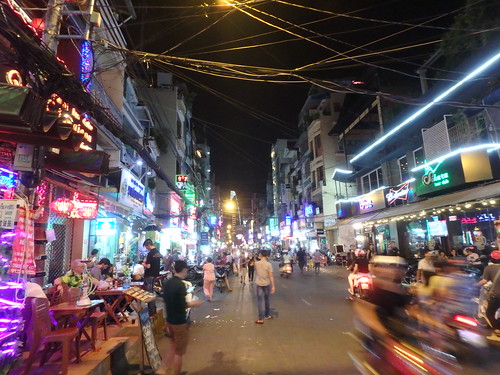 Pham Ngu Lao street
Pham Ngu Lao street
Throughout this journey this has been a constant source of confusion for me. I had always thought of backpackers as travellers who had strict budgets and were keen to explore. They were, in my opinion, willing to walk the extra mile to find a better bargain. Consequently, they also lived with much more exposure to the local culture than the ones living in resorts or hotels and spending time in utmost luxury. I was coming to realise that either my understanding of the word was wrong or it had come to mean something else altogether. Now-a-days the word backpacker stood for someone :
- who was primarily young.
- who partied every night.
- who spent loads on drugs, alcohol and prostitution.
- who lived in flashy recommended lodgings; party hostel chains (yes, there exists such a thing!) many a times.
- who did tours and took package trips with other “backpackers”.
While I have met a handful who were as I had imagined backpackers to be, the majority has been as I described above. With so many definitions floating around, it is difficult to categorise who is what but a backpacker definitely does not mean what I had thought it to.
Anyway, I walked past and out to the main street. I was looking for a cafe to sit and write a bit in but I could not find one of those street side cafes that I had found a profusion of in the other towns. I went into a packed and expensive looking coffee shop never the less. 50k for a Ca Phe Sua Da. The coffee was good though and I sat between loud Vietnamese kids who were enjoying their evening. Saigon seems much more advanced (or westernized) than Hanoi. I liked it though. Such joints do not necessarily mean that they are losing their culture, but rather that they are coming out of their cocoon.
I went back to the hostel and got a couple of printouts of the e-visa. Some nationalities are able to get visa on arrival at the Cambodian border but Indians, as can be guessed, cannot avail that facility. We need our visas beforehand and the easiest way to do it is the Cambodian e-visa. It costs you 40 USD (37 for the visa and 3 for processing fee) and is usually in your mail box a couple of days after applying. The entire process is hassle free and quite simple.
Cambodia Tip #1
If going to Cambodia, avail their e-visa facility. It is extremely simple and hassle free.
I took a bath and then went to bed after an irritating conversation with a fellow dorm-mate. He was an old Thai man who was obsessed with monkeys and wanted to know if everyone shat and pissed on the streets in India. I laughed him off, probably because I did not want to acknowledge the shameful reality from recent past. I told him, and hoped inwardly, that things were getting better.
Crossing Borders
I woke up and checked out of the hotel. The bus was at 1 PM and I had enough time to go looking for some food. I walked to the other side of the bus stand, following up on some vague online recommendations for local specialties. I could not find any of the specialties but settled for a plate of Com Tam before heading back to the Phuong Heng office.
Saigon Tip #1
District One is costly. VERY costly. A meal will typically cost you 2-3 times of what it costs elsewhere in the country.
When it was time, a guy walked us to the bus which stood waiting in the bus station. The seats looked comfortable and I tried sleeping as the bus moved out of Saigon. However, I had trouble falling sleeping. I guess I am not very comfortable in spacious seats. I find it easier to crawl into a corner and doze off rather than tumble about in a huge seat.
The bus stopped a couple of hours after departing Saigon. We were at the Bavet border crossing. First up was the Vietnamese checkpoint. The conductor had come around earlier to collect our passports. I had an e-visa but the ones that wanted to get a visa on arrival had to cough up 35 USD. The conductor, in turn, took care of the entire procedure, which, though not much, saved some time. He took the passports and handed the over to the immigration officer inside the building. We had to take our bags and put them through a scanner and then wait till our passport was processed. Then walked up to the counter, collected the passport, got it checked for the stamp by the guard at the gate and sat inside the bus that was waiting for us. The entire process takes less than 15 minutes.
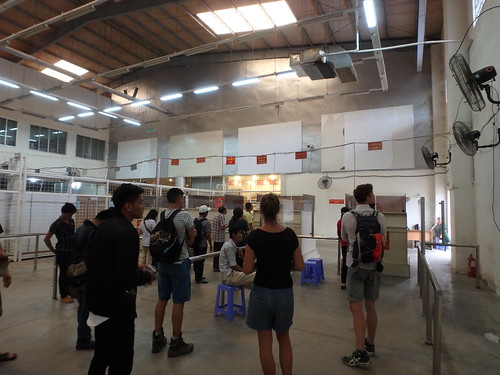 Getting stamped out of Vietnam
Getting stamped out of Vietnam
Once everyone was back, the bus moved a couple of hundred meters to the Cambodian checkpoint. Here we got off again and handed our passports to an official who glanced at our faces to fleetingly compare it with the passport’s photograph. We were made to enter and walk out of a building since the conductor was taking care of the visas. This was something of a formality and there were no scans or checks done. The bus was waiting for us at the exit gate and we got into it. There were a few people selling Cambodia currency and mobile SIM cards which I avoided due to uncertainty of their authenticity. Once everyone, except the conductor, was in, the bus started again and made it’s way into Cambodia. Casinos, big and small, lined the highway on either sides.
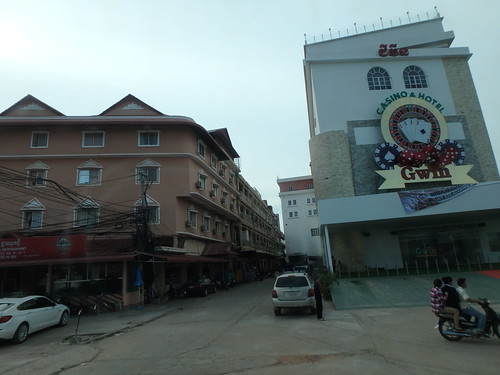 Casinos on the Cambodian side
Casinos on the Cambodian side
The anxious passengers started questioning the driver as to the missing passports and he told them to wait. We stopped in a couple of kilometers at an eatery. The food was over-priced and you could use your leftover dongs to pay for the meal.
Cambodia Tip #2
I know it is strange to leave your passport in the hands of a bus assistant but the Bavet border crossing has a rather streamlined process and you should generally not worry about the passports. You wait at an eatery while the conductor gets the passport processed at the checkpoint.
I got talking to the two Israelis on the bus while we had lunch. They were Eitan and Daniel and they were not doing India unlike most of the Israelis. I suppose they fancied the unusual as well. They had completed their military service and were travelling before joining school. We ate, paid our bills and sat in the bus. The assistant was back and came around distributing the passports. We had managed to enter Cambodia without any check of any sort. Neither had we been verified against our passports nor had our luggage been scanned for what we were carrying. Eitan called this lazy rather than convenient. I could not agree more.
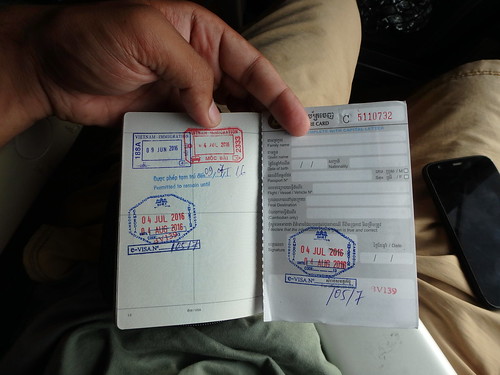 Stamped into Cambodia without a check 🎉
Stamped into Cambodia without a check 🎉
We made our way into Cambodia. The first difference, as Daniel had pointed out, was that Cambodian men can grow facial hair, unlike their Vietnamese counterparts. 😅 The most obvious contrast was, however, Cambodia’s poverty. The infrastructure was in a ramshackle state. However, the highway was good enough and we headed to Phnom Penh with some speed. We stopped once more at a highway mart to use the toilets and buy some snacks. It started raining and the traffic held us up just as we entered Phnom Penh but we made it to the stop soon after, within the 6 hours that the company had promised.
Another obvious difference was that the Cambodian tuk-tuk and motodop drivers were better with their English and much more irritating and persistent than the Vietnamese ones. Daniel, Eitan and I set out to search for hostels. The tuk-tuks were offering to take us to the hostel area for 2 USD but we decided to walk instead. These guys liked to do it in the old fashioned way; no GPS, just a Lonely Planet guidebook and a maps.me app. I did not find it the most efficient of ways but since I did not have network myself, I went along. We wandered in the lanes and found some guest houses offering rooms for the night or shorter periods (3-4 hours). Phnom Penh’s shadier side was just getting started. It started drizzling and the guys got themselves a double room in one of the LP recommendations. It was too costly for me as a solo traveller, so I decided to get a dorm. A short lived WiFi connection told me which direction to walk in. The street lights were not always working and the city seemed to be way too underpopulated for a capital. Things seem much more shadier than they had been in the neighbouring two countries (Thailand and Vietnam). There was garbage strewn all over the roads and the roads were downright filthy in places. The pavement was mostly broken or dug up or doubled up as parking space. A lot of this reminded me of the India I had seen while growing up.
I walked 30 minutes in the dark and drizzle to get to Velcommen Backpackers by the riverside. Here I was over-quoted the price once again and when I told them that I would rather book through agoda, they brought down the rate to match the listed price. I don’t know why this is so but I do not like it for sure. Do not list your place on agoda if it is economically infeasible, but stop varying your rates so! I went to the dorm room and dropped my bags. There were a few English kids sitting around. I climbed up the wobbly dorm bed and sat a while to cool down. Then I took a shower and headed out to search for some food.
EVERY tuk-tuk and moto driver in Phnom Penh calls out to you. And there are quite a few of them. If three of them are standing together, all three will take a shot at you one by one. It gets on your nerves after a while. I had to relearn how to rudely ignore them after the first few nays. I found an eatery a short walk away that served food and Cambodia’s favourite beverage - beer. Had a plate of Lok Lak and a glass of Anchor beer to fill me up for the night.
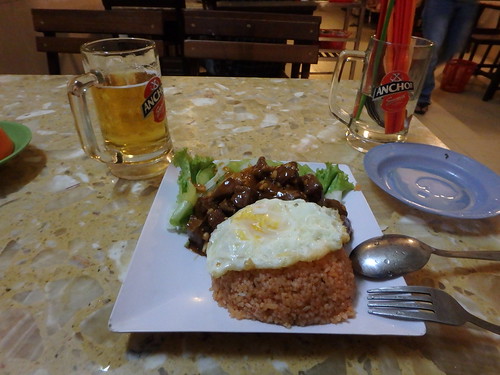 Beef Lok Lak
Beef Lok Lak
The prices are in dollars so that makes things a bit expensive. I had thought that Cambodia, being poorer than Vietnam, would be cheaper than Vietnam. This was definitely not the case. Though it was not breaking my bank, Cambodia was proving to be much more expensive than I had thought it would be. The Cambodian riel is something of a change currency and most of the transactions are made in dollars. Even the ATMs out here dispense USDs.
Cambodia Tip #3
Do not exchange currency while travelling to Cambodia. Get USDs from wherever you are starting and use them in Cambodia. If you run out of cash, the ATMs in the country dispense USDs as well which is convenient to carry the leftover cash. The Cambodia riel is simply a change currency and will not be accepted (even for exchange) anywhere outside Cambodia.
Whether you enjoyed the post or not, do leave a comment!
Find the previous posts in this series here.